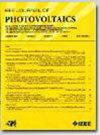Weather Responsive Multidimensional Photovoltaic Efficiency Model for Simulation of Custom-Built Bifacial Panel
IF 2.5
3区 工程技术
Q3 ENERGY & FUELS
引用次数: 0
Abstract
A generalized model for predicting the relative efficiency of photovoltaic (PV) panels responsive to weather dynamics is developed in this article. The mathematical framework is derived using correlation analysis of experimental testbed measurements. The testbed included a mono and a custom-built bifacial panel with single-axis tracking. The bifacial panel was made using two mono-facials with a gap between the front and back surfaces, making the panel highly sensitive to the dynamics of weather variations. The proposed bifacial as well as commercial PVs are modeled based on the developed mathematical framework. PV systems with the proposed and commercial panels are investigated. Simulation results show that the developed model accurately portrays the values achieved in the experimental testbed for the proposed panel. Performance study of the proposed panel-based PV system produced the highest energy with space consideration in contrast to commercial panels while being economically effective.用于模拟定制双面板的天气响应式多维光伏效率模型
本文建立了一个通用模型,用于预测光伏(PV)电池板响应天气动态的相对效率。数学框架是通过对实验测试平台测量结果的相关分析得出的。试验台包括一个单面和一个定制的双面单轴跟踪面板。双面板由两个单面板组成,前后表面之间有间隙,因此对天气变化的动态非常敏感。根据开发的数学框架,对拟议的双面和商用光伏系统进行了建模。研究了采用拟议的双面光伏板和商用光伏板的光伏系统。仿真结果表明,所开发的模型准确地描绘了拟议面板在实验测试平台上达到的数值。对基于拟议面板的光伏系统进行了性能研究,与商用面板相比,考虑到空间因素,该系统产生的能量最高,同时具有经济效益。
本文章由计算机程序翻译,如有差异,请以英文原文为准。
求助全文
约1分钟内获得全文
求助全文
来源期刊

IEEE Journal of Photovoltaics
ENERGY & FUELS-MATERIALS SCIENCE, MULTIDISCIPLINARY
CiteScore
7.00
自引率
10.00%
发文量
206
期刊介绍:
The IEEE Journal of Photovoltaics is a peer-reviewed, archival publication reporting original and significant research results that advance the field of photovoltaics (PV). The PV field is diverse in its science base ranging from semiconductor and PV device physics to optics and the materials sciences. The journal publishes articles that connect this science base to PV science and technology. The intent is to publish original research results that are of primary interest to the photovoltaic specialist. The scope of the IEEE J. Photovoltaics incorporates: fundamentals and new concepts of PV conversion, including those based on nanostructured materials, low-dimensional physics, multiple charge generation, up/down converters, thermophotovoltaics, hot-carrier effects, plasmonics, metamorphic materials, luminescent concentrators, and rectennas; Si-based PV, including new cell designs, crystalline and non-crystalline Si, passivation, characterization and Si crystal growth; polycrystalline, amorphous and crystalline thin-film solar cell materials, including PV structures and solar cells based on II-VI, chalcopyrite, Si and other thin film absorbers; III-V PV materials, heterostructures, multijunction devices and concentrator PV; optics for light trapping, reflection control and concentration; organic PV including polymer, hybrid and dye sensitized solar cells; space PV including cell materials and PV devices, defects and reliability, environmental effects and protective materials; PV modeling and characterization methods; and other aspects of PV, including modules, power conditioning, inverters, balance-of-systems components, monitoring, analyses and simulations, and supporting PV module standards and measurements. Tutorial and review papers on these subjects are also published and occasionally special issues are published to treat particular areas in more depth and breadth.
 求助内容:
求助内容: 应助结果提醒方式:
应助结果提醒方式:


